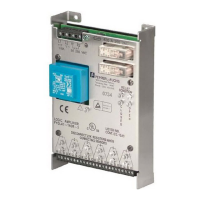21
Door Interrupt System with FYQLA1-140R-3 Logic Amplier
Functional safety related parameters*
Safety function
Relay output closed only when sensors activated by
appropriate target
Safe state
Relay output open
Standards/regulations ISO 13849-1 :2015/UL 508
Performance level acc. to ISO 13849-1 PL d
Structure acc. to ISO 13849-1 Category 3
MTTF
d
(years)
75850
DC
d
98.6 %
PFH 2.06 x 10E
-7
CCF
5 %
T
M
(years)
20
Pollution degree
2
Over-voltage category
(OC) II
Rated insulation voltage 250 V
Protection degree IP20, Class 1 “indoor use only”
Housing material 304 stainless steel
Internal hardware diagnostic fault
detection
< 4 s
*The following assumptions were made during the failure modes, eects, and diagnostic analysis (FMEDA) of the
FYQLA1-140R-3:
• Failure rates are constant, wear out mechanisms are not included.
• Failure rates are based on the Siemens standard SN29500.
• Power supply failures are not included in the FMEDA, a loss of power introduces the safe state.
• It was assumed that the appearance of a safe error (e. g., output in safe state) would be repaired within 8
hours (e. g., remove sensor burnout).
• During the absence of the device for repairing, measures have to be taken to ensure the safety function (for
example: substitution by an equivalent device).
• The stress levels are average for an industrial environment and can be compared to the Ground Fixed
Classication of MIL-HDBK-217F. Alternatively, the assumed environment is similar to IEC 60654-1 Class C
(sheltered location) with temperature limits within the manufacturer’s rating and an average temperature over
a long period of time of 40 °C. Humidity levels are assumed within manufacturer’s rating. For a higher average
temperature of 60 °C, the failure rates should be multiplied with an experience based factor of 2.5. A similar
multiplier should be used if frequent temperature uctuation must be assumed.
Product specications (cont.)

